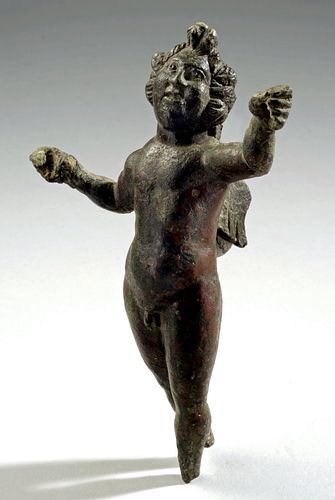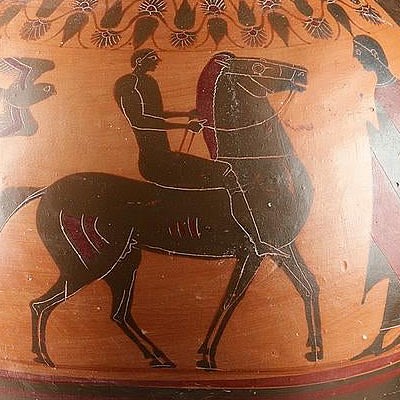Roman Bronze Cupid in Lares Pose, Art Loss Register
Lot 61
About Seller
Artemis Gallery
686 S Taylor Ave, Ste 106
Louisville, CO 80027
United States
Selling antiquities, ancient and ethnographic art online since 1993, Artemis Gallery specializes in Classical Antiquities (Egyptian, Greek, Roman, Near Eastern), Asian, Pre-Columbian, African / Tribal / Oceanographic art. Our extensive inventory includes pottery, stone, metal, wood, glass and textil...Read more
Estimate:
$5,000 - $6,500
Absentee vs Live bid
Two ways to bid:
- Leave a max absentee bid and the platform will bid on your behalf up to your maximum bid during the live auction.
- Bid live during the auction and your bids will be submitted real-time to the auctioneer.
Bid Increments
| Price | Bid Increment |
|---|---|
| $0 | $25 |
| $300 | $50 |
| $1,000 | $100 |
| $2,000 | $250 |
| $5,000 | $500 |
| $10,000 | $1,000 |
| $20,000 | $2,500 |
| $50,000 | $5,000 |
| $100,000 | $10,000 |
| $200,000 | $20,000 |
About Auction
By Artemis Gallery
Jun 4, 2020
Set Reminder
2020-06-04 10:00:00
2020-06-04 10:00:00
America/New_York
Bidsquare
Bidsquare : Exceptional Antiquities, Asian, Ethnographic
https://www.bidsquare.com/auctions/artemis-gallery/exceptional-antiquities-asian-ethnographic-5185
An important one-day auction featuring museum-worthy examples of Egyptian, Greek, Roman, Etruscan, Near Eastern, Far East / Asian, Pre-Columbian, African / Tribal, Oceanic, Native American, Spanish Colonial, Russian, Fossils, Ancient Jewelry, Fine Art, so much more! Artemis Gallery info@artemisgallery.com
An important one-day auction featuring museum-worthy examples of Egyptian, Greek, Roman, Etruscan, Near Eastern, Far East / Asian, Pre-Columbian, African / Tribal, Oceanic, Native American, Spanish Colonial, Russian, Fossils, Ancient Jewelry, Fine Art, so much more! Artemis Gallery info@artemisgallery.com
- Lot Description
Roman, Imperial Period, ca. 2nd to 3rd century CE. Skillfully cast via the lost wax (cire perdue) technique, a bronze statue of Cupid (Greek Eros) - the god of love - presented in a dynamic serpentine pose that begs the viewer's eyes to move around the figure. Cupid/Eros is standing on his left leg while his right leg is drawn back, his left arm raised as if offering what is held in his hand, his right hand extended outward and also posed to hold an object. He strides forward in a jubilant dance-like manner, all the while brandishing a joyful expression. Interestingly, this pose is reminiscent of the Lares (Roman guardian spirits) who traditionally hold a vessel for drinking wine or pouring libations in their upraised hand and a phiale or saucer in their lowered hand. Size: 4.57" H (11.6 cm)
Cupid's body is finely modeled in the nude with delineated nipples, buttocks, and genitalia. His outspread wings flutter behind his shoulders with well-defined plumage. In addition to capturing the god in motion, the sculptor of this piece has rendered an expressive visage with generously lidded almond-shaped eyes, delineated pupils/irises, a perky nose, parted lips as if singing or laughing - his cherubic rounded visage framed by curls with a prominent knot of hair above his forehead. The hair atop his head is braided with curls cascading over the back of his neck.
We believe that this figure was most likely cast in a local workshop that specialized in this form during the second and third centuries CE. A characteristic type, known from the Hellenistic and Roman periods, this bronze statue of Cupid is comparable to bronzes created in Roman Gaul or Germany. Other examples came from the northern and western provinces of the Roman Empire. Scholars believe that such statues of Cupid (Eros) carrying objects may have served as votive offerings to the god of love - or - when accompanying Venus (Aphrodite) such erotes likely served as attendants to the goddess or represented the maternal bond between Venus and Cupid. A very special statue of the Roman god of love and the son of Venus whose name is derived from the Latin cupido, meaning "desire"!
This piece is accompanied by an Art Loss Register Certificate.
Provenance: private New York, USA collection; acquired in the late 1970s to early 1980s; accompanied by Art Loss Certificate
All items legal to buy/sell under U.S. Statute covering cultural patrimony Code 2600, CHAPTER 14, and are guaranteed to be as described or your money back.
A Certificate of Authenticity will accompany all winning bids.
We ship worldwide and handle all shipping in-house for your convenience.
#155920Losses to feet. Missing objects once held in hands. Normal surface wear commensurate with age. Incredible dark green and russet red patina.Condition
- Shipping Info
-
All shipping is handled in-house for your convenience. Your invoice from Artemis Gallery will include shipping calculation instructions. If in doubt, please inquire BEFORE bidding for estimated shipping costs for individual items.
-
- Buyer's Premium



 EUR
EUR CAD
CAD AUD
AUD GBP
GBP MXN
MXN HKD
HKD CNY
CNY MYR
MYR SEK
SEK SGD
SGD CHF
CHF THB
THB

















